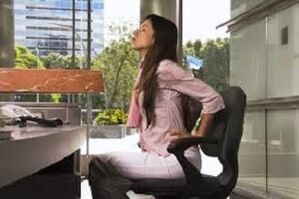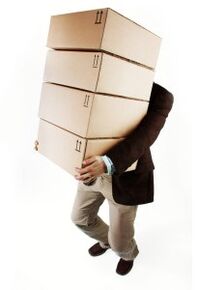Lumbar osteosarcoma is a common disease of the spine. There is degeneration of cartilage tissue into bone, degeneration of discs. Reduced in size, annular fibrosis cannot cope with the functional deterioration of the vertebral sections, creating pressure on the nerve endings of the spinal cord, causing low back pain.
Developmental stages of lumbar osteonecrosis
- The main sign of the development of osteonecrosis is discomfort in the lower back.
- The second stage is characterized by protrusion of the discs: the capsule is destroyed, the intervertebral disc spaces are reduced, pain occurs when nerve endings are compressed.
- In the third stage, the spine is deformed, the fibrous annular is destroyed due to the movement of the disc being displaced, and the contents inside are leaked out. A herniated disc mass is formed.
- The fourth stage is acute osteonecrosis of the lumbar spine. It is considered severe, back pain that interferes with movement.
Symptoms of the disease

The first call that signals the development of degenerative osteopathy of the lumbar spine is the periodic pathology, back pain. Depending on the slope of the invasion, the pain is accompanied by shooting, aching, pain spreading down the legs, buttocks, thighs.
Characterized by diseases after a long time in a horizontal position. A person cannot bend for a while after sleeping. In the lumbar region, pain of different nature occurs: dull, aching, insensitivity of soft tissues due to invasion of nerve endings. Running with lumbar osteochondrosis will cause pain when you can drag your legs.
Usually, with prolonged compression of the nerve roots, the development of osteonecrosis develops, the work of the internal organs is disrupted, insensitivity of the genital organs, dysfunction of the internal organs. genitourinary system. The change in position of the vertebral discs leads to partial invasion of blood vessels, causing vascular dystonia, in which blood does not circulate in sufficient quantity to the lower body, not circulating normally. Painful internal organs, partial numbness of the extremities, convulsions are observed.
With sudden movements, coughing, back pain can be observed - sharp pain, which quickly disappears, comparable to an electric shock. With the development of diseases of the lumbar region, the reflex functions of the tendons of the lower extremities weaken.
If you suspect that you have a disease, or if you experience repeated pain, you should see a doctor for advice and diagnosis. If it goes away on its own, the disease will progress to a very dangerous state. Time lost due to disregard for health will work against the patient.
Cause of disease
The reliable cause of lumbar osteonecrosis is not known. The disease is formed with a combination of adverse factors affecting the changes of bone and cartilage tissues. Internal factors influence the premature aging of bone tissue:
- Functional disorders of the endocrine system;
- Autoimmune disorders;
- Improper metabolism;
- Microtrauma of the spine;
- Hormonal disorder;
- Dehydration of the body;
- Genetic.
The external factors affecting the formation of the disease should be called the influence of the environment, physical activity, habits. Factors:

- Periodic overactivity of the back muscles;
- Weightlifting;
- Muscle hypotension;
- Spinal overload;
- Improper posture;
- Poor nutrition;
- Bad habits;
- Stress.
Usually lumbar osteonecrosis occurs in people who do regular jobs: shopkeepers, teachers, security guards.
At risk are occupations that involve electrical loads: athletes, builders, porters. A common form is sciatica, prolapse, and dislocation of the disc. The sedentary work of office workers, civil servants, programmers, and drivers leads to reduced movement of the back muscles. The job of maintaining a straight posture falls on the spine, changes in posture, compresses nerve tissues, blood vessels, and numbness in the extremities.
Treatment of lumbar osteonecrosis
In case of acute pain in the lower back, a medical facility should be contacted for a comprehensive examination to determine the cause of the pain sensation. It could be appendicitis, biliary colic, another disease with the same main symptoms as lumbar osteonecrosis.
Depending on the progression of the disease and syndrome, the doctor prescribes treatment methods including drug therapy, physical strengthening exercises, wellness procedures and diet. Surgical intervention is reasonable in the final revision of the spine. Drug treatment includes the use of ointments, injections, patches, tablets. Dosage, course of treatment depends individually on the patient's condition, ignoring the disease.
- The initial task in the treatment of osteonecrosis is to relieve acute pain, tension, and muscle spasticity. Application:
- Non-steroidal anti-inflammatory drugs in the form of injections, tablets. After taking painkillers, reduce inflammation of the tissues.
- Medicines that relieve symptoms are pain relievers.
- Antispasmodics are short-acting, relaxing muscle fibers located around the heart of the pain.
- The drug enhances microcirculation, increases blood flow to the organs, provides oxygen and necessary substances to the body.
- Diuretics to reduce swelling and pressure on the spine.
- To restore cartilage tissue, its nutrition uses two branches of medicine:
- Chondroprotectors - ointments, tablets, injections containing enzymes that promote the regeneration of cartilage tissue. Apply a long-term course of up to six months with a break of 2-3 months.
- The vitamin complex accelerates the recovery of cartilage tissue, nourishes the intervertebral disc with necessary substances.
- The main drug treatment is indicated after the patient undergoes an MRI scan, determining the cause of the disease.
The listed appointments are short-term measures, they do not affect the course of the disease, they alleviate the patient's condition. To cure the disease, it is indispensable to relieve pain and treat symptoms. We need a smart and holistic approach.
For recovery, physical therapy procedures should be used that improve blood circulation and stimulate the lumbar muscles. Effective methods are electrophoresis, magnetic field, ultrasound, laser treatment.
Among physiotherapeutic exercises, yoga has a demand on the osteolysis of the lumbar spine. Simple, stretching poses relieve tension from the muscles, strengthening them. Independent sports without proper training, insurance guidance can cause serious harm.
How to protect yourself from osteonecrosis?
Prevention of degenerative lumbar spine disease includes regular back exercises, an active lifestyle and a properly balanced diet. The load on the belt should be uniform. Using a firm mattress when sleeping helps reduce the risk of disease. Regular, yearly doctor visits after age 40 will provide early diagnosis and detect predispositions.















































